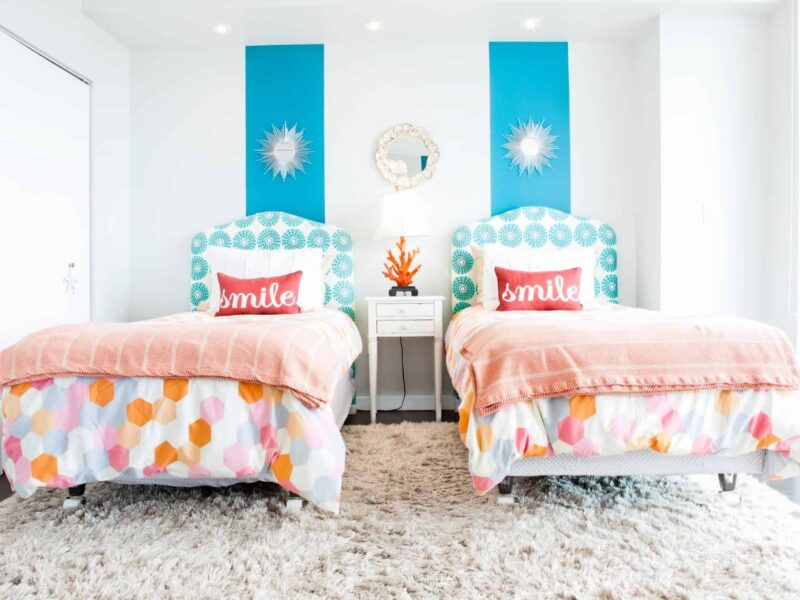
It’s common practice for siblings to share a bedroom. Why it’s done depends on circumstance. Parents want their kids to get on with each other and hope that sharing will create a positive bonding experience.
Often necessity forces the situation. With house prices continuing to rise it’s not always possible for each of your children to get their own room.
Benefits of Siblings Sharing a Bedroom
Many childcare and parenting experts extol the benefits of sharing a bedroom, often having done so themselves when they were younger. Positive results of siblings sharing a bedroom include:
- Space in the house is maximized.
- Furniture in the house is maximized.
- Children learn to compromise.
- Children learn to share.
- Children bond, given their close proximity.
- Children are given the tools they will need when sharing a room later at university, or living with roommates in private accommodation.
Drawbacks of Siblings Sharing a Bedroom
Siblings who share a bedroom will never be without their share of squabbles. The drawbacks of siblings sharing a bedroom include:
- Personality clashes.
- Arguments over space and property.
- Disagreements over decorating.
- Bickering stemming from sharing a small space.
- Feeling that there are no private spaces or possessions in the house.
How to get kids to love their shared bedroom
Whichever road brought you here, getting kids to like (or tolerate) sharing a room continues to be a hot topic. Think about what you can do to make life simpler for everyone involved.
Start young
For many it is natural for the youngest child to begin sharing with an older sibling once they’ve outgrown their crib. Sharing a room from this age can be simpler as your children will become accustomed to the set up.
If you’re lucky enough for your little ones to sleep well, sharing a bedroom can help them feel more secure and comfortable at night.
Giving kids their own space as they grow can be tricky in a small house, this can be more difficult if you have a boy and a girl or more than two siblings sharing. Think creatively when it comes to organising and decorating.
Pick a colour
Each child gets to pick a colour scheme for one wall or area to give them their own ‘space’. Offer different colours for the children to pick from, either contrasting ones or complementary.
If they can’t decide on individual schemes consider shades of the same colour. You don’t have to limit the colours to décor; how about matching bedding and furniture to create individual ‘zones’?
Room separator
Finding it tricky to split a room for a brother and sister? Paint a small piece of MDF and attach to a wall to literally divide a room in two. If you have the right tools you could even shape it into the outline of a small house!
Both children can pick the colour for their side of the divider and furnishings for their part of the room.
Alternatively, pop a curtain rail onto the ceiling and divide the room with a piece of fabric. The curtain can be drawn out of the way if required during the day (or used if one of the kids wants some quiet time to chill out).
Even with a limited amount of space, children can put their stamp on a room with small accessories. If you decide on a neutral room, or your children are simply unable to decide upon a shared theme, consider allowing each child to pick out their own:
- Pictures or posters for the wall.
- Duvet or bedspread.
- Towels.
- Decorative pillows
- Alarm clock.
- Hangers.
Individual storage
Even if space is tight it’s recommended that kids have their own storage, whether a drawer in a chest, a basket for under the bed or their own shelf.
Giving each child personal space will allow them to express their personality. Think about making the most of awkward spaces to put up a few floating shelves or use clever under-bed storage for them to store treasured items.
Set some ground rules
Getting everyone to understand what acceptable behaviour is can reduce bickering and be easier to set boundaries, particularly for older children. Set rules relating to using other people’s things, keeping individual space tidy and respecting when a sibling wants some quiet time.
Think ahead to nip potential problems in the bud. A pair of headphones for one child to listen to music while the other reads in a quiet corner may be all it takes to prevent an epic argument.
As your children grow and temperaments, habits and tastes change you’ll need to get more creative. Allow kids to change their décor every so often.
Chances are your eight year-old won’t want that Peppa Pig bedding set that they loved when they were five! Be flexible and make new rules to suit your current needs. For example if one child needs a dark room to get to sleep and the other prefers to read for a while then stagger bedtimes.
Help your kids to define and make the most of their shared space; they might just come to love sharing. And just think – with them sharing there will be less rooms to keep clean!

